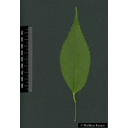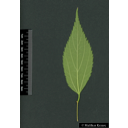Useful information about the taxon (species, subspecies, variety...)
Celtis tournefortii Lam. 1797
Cannabaceae
(APG IV)Oriental hackberry, Oriental nettle tree
Taxon concept: The Plant List (2010)
Distribution: southeastern Europe: Sicily (with Malta), Cyprus, Balkan peninsula, Crimea; Turkey, Caucasus, Northern Iraq, Northern Iran
Celtis tournefortii Lam. - Accepted: Celtis tournefortii Lam. bei Zander 2008; Familie: Ulmaceae (Zander 2008)Celtis tournefortii Lam. - Accepted: Celtis tournefortii Lam. bei The Plant List (2010); Familie: Cannabaceae (APG III)Celtis tournefortii Lam. - Accepted: Celtis tournefortii Lam. bei The Plant List (2014), version 1.1; Familie: Ulmaceae (APG III)Celtis tournefortii Lam. - Accepted: Celtis tournefortii Lam. bei The Plant List (2014), version 1.1; Familie: Cannabaceae (APG IV)
- Flowers
- hermaphrodite flowers
- Flower ecology
- insect-pollinated (entomophilous) (bees)
- Life form
- shrub or small tree
- Foliage persistence
- deciduous
- Fruits
- fruit is a orange-yellow drupe
- Fruit ecology
- animal-dispersed (zoochorous, ornithochorous)
- Soil conditions
- preferentially on dry to mesic, nutrient-rich, sandy, sandy-gravelly or sandy-humus containing soils
- Natural occurrence (habitat)
- dry forests, rocky slopes, maquis, bushy places, steppes
- Vegetation typ and synecology (plant community)
- warm-temperate (Mediterranean), dry-mesophytic evergreen sclerophyll forests, woodlands, and shrubs
- Constraints according moisture
- drought-tolerant
- Usage
- the fruit is edible and consumed in Turkey
Breunig, T. et al. (2021): Rote Liste der Farn- und Blütenpflanzen Baden-Württembergs.; Bundesamt für Naturschutz (BfN) (1999-2001 and ongoing): Floraweb - Daten und Informationen zu Wildpflanzen und zur Vegetation Deutschlands. www.floraweb.de.; Erhardt, W., Götz, E., Bödeker, N. & Seybold, S. (2008): Der große Zander. Enzyklopädie der Pflanzennamen. Band 2. Arten und Sorten. Eugen Ulmer KG, Stuttgart (Hohenheim), 18. Aufl., 2103 S.; Metzing, D. et al. (2018): Rote Liste und Gesamtartenliste der Farn- und Blütenpflanzen (Trachaeophyta) Deutschlands .; Ministerium für Ernährung, Landwirtschaft, Umwelt und Forsten, Baden-Württemberg (Hrsg.) (1985): Pflanzenkatalog zur Verbesserung der Bienenweide und des Artenreichtums (Kurztitel: Bienenweidekatalog); The International Plant Names Index (2009). Published on the Internet http://www.ipni.org; Courtesy to IPNI, 2009. Exported from IPNI at date: 2009-09-22 20:17:51;
Diese Webseite verwendet Google Maps, um Karten und Standorte von Pflanzen in den Hohenheimer Gärten anzuzeigen. Dadurch werden unter Umständen Daten an Google weitergeleitet, was mit einer Verarbeitung Ihrer personenbezogenen Daten verbunden sein kann. Die Datenschutzerklärung von Google finden Sie hier: Datenschutzerklärung von Google
| Sex | Standort | Accession number | Planting year | Donation | IPEN | Lat. | Long. |
|---|---|---|---|---|---|---|---|
| Parzelle N | SP-NB-076-5920 | 1999 | XX-0-HOH-SP-NB-076-5920 | 48,7115068625 | 9,2166285778 |


